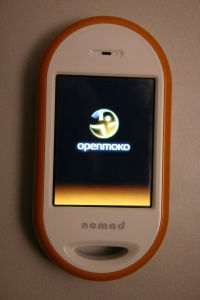Getting Started with your Neo 1973
From Openmoko
(→By using the terminal emulator and on-screen keyboard) |
(→By using the terminal emulator and on-screen keyboard) |
||
| Line 49: | Line 49: | ||
From the desktop, choose "Active tasks->rxvt" to get a root shell. | From the desktop, choose "Active tasks->rxvt" to get a root shell. | ||
| + | |||
| + | Terminal is in the top level menu in recent images. | ||
=== By using Ethernet emulation over a USB cable === | === By using Ethernet emulation over a USB cable === | ||
Revision as of 16:41, 9 May 2007
Some first steps guide for those who have just received their first Neo1973 hardware
Contents |
Hardware
Inserting the battery
Powering up the phone
Just hitting the power button (depending on your u-boot version you have to press for >= 5 seconds) should get the phone first into the bootloader, then boot the kernel, and get into X/GPE.
Once you have pressed the power button sufficiently long, the vibrator makes a short pulse and the screen backlight turns on. You can now release the power button and watch the phone booting.
Powering down the phone
While in bootloader mode, or if the phone has crashed
If you press the power button for 9 seconds, the phone will switch off. You can notice this by the backlight going dark.
While running a full linux system with userspace
In this mode, a power-button press of 5 seconds will be sufficient. After this, the init process will take care of safely shutting down the phone, which might take up to 20 extra seconds. The X server should get killed, you should drop back to a (garbled) console, and it should finally switch off - much like a regular Linux PC.
Battery charging
The Neo1973 supports two charging modes: One 100mA charge mode (called pre-charge) and 500mA (called fast charge). Charging is always done via the USB socket. You can use any USB-A to USB-mini-B cable to connect the phone to any USB host.
While in u-boot
While you are in u-boot mode, the phone only charges with 100mA by default. (This will change in one of the future revisions).
However, using the u-boot console you can manually enable fast charging. See U-boot#Battery_charger_related for more information.
While in Linux
As soon as the phone is connected via USB cable, it will charge. However, the default charging current is only 100mA, way too little if you want to operate the phone and charge at the same time.
If your USB upstream port is capable of supplying 500mA, then it will configure the Neo1973 accordingly and use 500mA charging mode. You can notice this by the following line in the kernel log
usb0: full speed config #1: 500 mA, Ethernet Gadget, using CDC Ethernet
Getting shell access on the phone
By using the terminal emulator and on-screen keyboard
"Click" (using a stylus) the top-left arrow icon to get a drop-down menu with "Media", "Settings", "Utilities" and "Desktop". Choose "Utilities->Panel->Input Manager", and a keyboard icon will appear on the top bar. You can get an on-screen keyboard at any time by choosing it.
With newer images, the keyboard comes up when you tap the white box in the top bar.
From the desktop, choose "Active tasks->rxvt" to get a root shell.
Terminal is in the top level menu in recent images.
By using Ethernet emulation over a USB cable
The standard Neo1973 Linux kernel has support for the "cdc_ether USB gadget", i.e. a standard implementation of how to emulate an Ethernet device over USB.
As soon as the kernel is up and running, and you have the phone connected via USB, you should get a usb0 device on your host.
The Phone will have the IPv4 address 192.168.0.202/24. You can run `ifconfig` in the terminal on the phone to verify this (this is optional, just check it if it doesn't work given the instructions below)
If you plug a USB cable into a laptop running Linux, you'll likely see the "cdc_ether" kernel module being loaded and a usb0 network interface appear.
On the host PC, you should then configure your interface to 192.168.0.200 by using
# ifconfig usb0 192.168.0.200 netmask 255.255.255.0
Then you should be able to
# ping 192.168.0.202
and last, but not least
# ssh root@192.168.0.202
Once you press 'enter' (empty password), you should now have a root login.
By using the debug board/serial/JTAG
Please see Debug Board#Usage_Instructions
Getting access to the bootloader console
Please see u-boot#Using_usbtty_from_Linux

